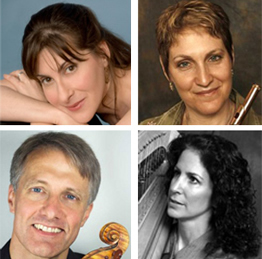The Eastern Music Festival Orchestra under Music Director Gerard Schwarz proved its mettle in a varied program which included two chestnuts and one rarely heard work. The concert opened with the most unfamiliar piece, a suite excerpted from Ferruccio Busoni’s incidental music to Turandot, a play originally by Italian playwright Carlo Gozzi, written in the 1700s to conform to the popular commedia dell’arte esthetics. (Most music-lovers are more familiar with Giaccomo Puccini’s tragic opera of the same name, although Puccini owes more to Friedrich Schiller, author of William Tell and “Ode to Joy” than to Gozzi).
Playing five of the original eight incidental pieces, Maestro Schwarz provided many of us with our first hearing of Busoni’s original compositions – his piano transcriptions being, on the other hand, ubiquitous! This music is full of colorful orchestrations of strangely contrasting moods, starting with the timpani played with hard sticks, to sharpen their melodic tuning, as they prepare us for an execution. Then commedia dell’arte stock character, Truffaldino (literally, “swindler”), the chief eunuch, in his “Grotesque March” and leading finally to a sort of Funeral March with a Turkish-style Finale, which reminded me of Mozart’s Rondo alla turca! It was refreshing to hear something far off the beaten path with its rich orchestration and unusual moods.
Young Augustin Hadelich, German violinist of Italian birth, played a very warm and intimate yet virtuosic version of the Tchaikovsky Violin Concerto without the usual cuts in the last movement. I enjoyed this thoughtful rendering of this war horse although at one moment I wondered if we were going to have intonation issues. Hadelich, winner of the 2006 Indianapolis Violin Competition, the leading U.S. competition of its kind, plays a Stradivarius lent to him through the auspices of the Stradivari Society. Not content with the effect of the Tchaikovsky on the audience (on our feet, shouting and stomping), he finally offered one of the most charming and precise performances of Paganini’s 24th Caprice as encore. This was brilliant, refined and subtle all at once – flying bow, flashing pizzicato, flute-like harmonics, all with warm tone and perfect intonation! I only wish Paganini had written repeats of the second section of each of the eleven variations as he did the first section!
Brahms deliberated long before he completed a symphony, creating on the way a piano concerto of symphonic proportions, two serenades – light weight symphonies in a lesser composer’s purview – and many major choral works before writing these four last great symphonies of the 19th century. Maestro Schwarz put a somewhat assertive bent on the performance of the Fourth Symphony which is often played in a more philosophical and relaxed manner. I had looked forward to hearing the woodwind canon (at the octave) at the beginning as melodic rather than part of the texture, and again 18 measures later when the lower strings take up the canon, at the fifth below. Nonetheless, the first movement continued with expressive continuity until an over-enthusiastic horn jumped the gun at the end of the development and shortly thereafter, an oboe found water blocking the high “C.” Later, a note unwritten by Brahms snuck into the passacaglia theme of the Finale. Nevertheless, this was playing of the highest quality – powerful horns at the beginning of the modal second movement; rich cello sound throughout; crisp Scherzo style in the Allegro giocoso, featuring a triangle-player who played his part on three different triangles(!), and a gorgeous flute solo by Clay Ellerbroek in the 3/2 section of the Finale.
The unexpected blips mentioned above led me to reflect after the concert and the next day, that this never happens with the Festival Orchestra – these musicians are beyond such mundane trivialities. Yet this is a live performance with real people taking musical risks that most orchestras eschew. Thank the gods that they take these risks because when they succeed, the musical results shine with singular originality. These mishaps are the exceptions that confirm and prove the rule: The Festival Orchestra of the EMF is a superb group of musicians playing at the highest professional level under the masterful leadership of a major musical personality. We are fortunate in the Southeast to have such a stellar ensemble to look up to. Please keep daring!











